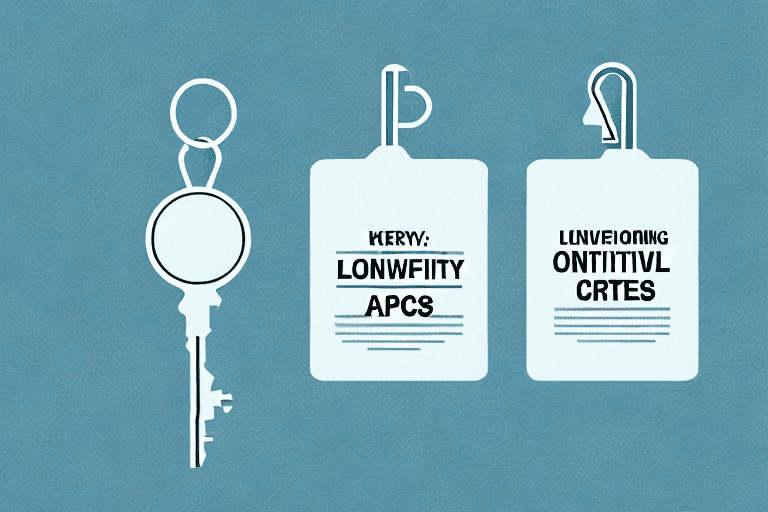In the world of intellectual property, licensing plays a crucial role in allowing businesses and individuals to leverage their creations and innovations for commercial gain. Licensing agreements grant permission to use and exploit intellectual property in exchange for certain conditions and considerations. Two commonly used types of licenses are confirmatory licenses and exclusive licenses. While they may seem similar at first glance, there are some key differences between them that are worth exploring.
Understanding Licensing in Intellectual Property
Welcome to the world of licensing in intellectual property! In this fascinating realm, legal agreements known as licenses are formed between the owners of intellectual property rights, called licensors, and other parties, known as licensees. These licenses grant the licensees the right to use and exploit the intellectual property, subject to certain terms and conditions.
Definition of Licensing
But before we dive into the specifics of confirmatory and exclusive licenses, let’s take a moment to define what licensing truly entails. In simple terms, licensing is a contractual arrangement that allows individuals or businesses to utilize intellectual property assets that they do not own.
Imagine a scenario where an inventor develops a groundbreaking technology but lacks the resources or expertise to bring it to market. By licensing their invention to a company with the necessary resources, the inventor can ensure that their creation reaches a wider audience and potentially generates significant revenue.
Licensing can cover various forms of intellectual property, including patents, trademarks, copyrights, and trade secrets. These legal agreements establish the rights and responsibilities of both the licensor and licensee, ensuring that the intellectual property is used in a manner that benefits both parties.
Importance of Licensing in Business
Now that we have a clearer understanding of what licensing entails, let’s explore the importance of licensing in the business world. Licensing plays a vital role in enabling companies to expand their offerings and generate additional revenue streams.
By granting licenses, businesses can effectively monetize their intellectual property assets without completely relinquishing ownership. This allows them to leverage their creations or innovations to their advantage, while still retaining control over their intellectual property rights.
For example, a software company that has developed a cutting-edge application can license it to other companies or individuals, allowing them to use the software for a fee. This not only increases the software company’s revenue but also extends the reach of their product, making it available to a wider audience.
Licensing also provides opportunities for collaboration and partnerships. By entering into licensing agreements, companies can join forces and combine their intellectual property assets, leading to the development of innovative products or services that wouldn’t have been possible otherwise.
Furthermore, licensing can help businesses expand into new markets or industries. By licensing their intellectual property to companies operating in different regions or sectors, businesses can tap into new customer bases and diversify their revenue streams.
In summary, licensing is a powerful tool that allows businesses to unlock the potential of their intellectual property assets. By entering into licensing agreements, companies can expand their offerings, generate additional revenue, foster collaboration, and explore new markets. So, whether you’re a licensor or a licensee, understanding the intricacies of licensing in intellectual property is essential for success in today’s dynamic business landscape.
An In-depth Look at Confirmatory Licenses
Definition and Purpose of Confirmatory Licenses
A confirmatory license, also known as a non-exclusive license, grants multiple licensees the right to use the intellectual property on a non-exclusive basis. In other words, the licensor can enter into these agreements with multiple parties simultaneously while retaining the ability to grant licenses to others as well.
Confirmatory licenses are a flexible and versatile tool in the world of intellectual property. They allow the licensor to expand the reach of their creations while still maintaining control over their use. By offering non-exclusive licenses, the licensor can tap into a wider market and potentially increase their revenue opportunities.
These licenses are particularly useful when the licensor wants to provide access to their intellectual property to a broad range of licensees. For example, a software developer may choose to offer confirmatory licenses for their application to reach a larger customer base. This approach allows them to penetrate the market more effectively and gain a competitive edge.
When to Use a Confirmatory License
Confirmatory licenses are typically used when the licensor wants to provide access to their intellectual property to a broad range of licensees. This approach allows the licensor to reach a larger market and enjoy increased market penetration. Additionally, confirmatory licenses are favored when the intellectual property has a relatively low level of specific technical know-how required for its use.
One scenario where confirmatory licenses shine is in the world of art. Artists often grant non-exclusive licenses to art galleries, allowing them to display and sell their artwork. This arrangement benefits both parties, as the artist gains exposure and potential sales, while the gallery can showcase a diverse range of artwork to attract customers.
Moreover, confirmatory licenses are particularly advantageous when the intellectual property is not highly specialized or dependent on specific technical expertise. For example, a clothing designer may offer non-exclusive licenses for their fashion designs, allowing multiple manufacturers to produce and sell their creations. This approach allows the designer to tap into different markets and expand their brand presence.
Pros and Cons of Confirmatory Licenses
Confirmatory licenses offer several advantages. Firstly, they provide a broader customer base, potentially leading to increased revenue opportunities for the licensor. By allowing multiple licensees to use the intellectual property, the licensor can reach a wider audience and increase their chances of success in the market.
Moreover, these licenses often involve lower fees and reduced administrative burdens due to their non-exclusive nature. Licensees may be more willing to enter into a non-exclusive agreement, as it allows them to explore different business opportunities without being tied down to an exclusive license. This flexibility can result in lower licensing fees and a smoother negotiation process.
However, confirmatory licenses also have downsides. One potential drawback is the potential competition between licensees. When multiple parties have access to the same intellectual property, they may compete with each other in the market. This competition can lead to price wars, reduced profit margins, or other challenges for the licensor.
Furthermore, confirmatory licenses may result in reduced control over the use of the intellectual property. Since multiple parties have the right to use the IP, the licensor may have limited control over how it is utilized. This lack of control can be a concern if the licensor wants to maintain a certain level of quality or protect their brand reputation.
Despite these disadvantages, confirmatory licenses remain a popular choice for many licensors. The benefits of broader market reach and increased revenue opportunities often outweigh the potential downsides, making confirmatory licenses a valuable tool in the world of intellectual property licensing.
Exploring the World of Exclusive Licenses
Welcome to the fascinating world of exclusive licenses! In this article, we will dive deep into the concept of exclusive licenses, exploring their definition, benefits, and drawbacks. So, let’s get started!
What is an Exclusive License?
An exclusive license is a powerful legal instrument that grants the licensee the sole right to use and exploit a specific intellectual property, excluding all others, including the licensor. It is a contractual agreement that provides the licensee with exclusive rights, prohibiting the licensor from granting licenses to anyone else once the exclusive license is in effect.
Imagine you have developed a groundbreaking technology or created a unique piece of art. By granting an exclusive license, you are essentially handing over the reins of your creation to someone else, giving them the power to utilize and profit from it while you step back.
Benefits of an Exclusive License
An exclusive license offers numerous advantages to the licensee. One of the primary benefits is the exclusivity it provides in a specific market or field. By obtaining an exclusive license, the licensee gains a competitive edge by preventing competitors from utilizing the intellectual property. This exclusivity can lead to a stronger market position and the potential for higher profits.
Moreover, exclusive licensees benefit from the ability to control and shape the use and development of the intellectual property. They have the freedom to explore different avenues, conduct research, and make strategic decisions without interference from the licensor or other licensees. This level of control allows licensees to fully exploit the potential of the intellectual property and tailor it to their specific needs.
Drawbacks of an Exclusive License
While exclusive licenses offer significant advantages, they also come with certain drawbacks. From the licensor’s perspective, granting an exclusive license means forfeiting the ability to monetize the intellectual property through other license agreements. This decision may limit the licensor’s revenue potential and restrict future opportunities for collaboration or licensing.
Additionally, entering into an exclusive license agreement requires careful consideration of the licensee’s capabilities and market reach. It is crucial for the licensor to assess whether the licensee has the necessary resources, expertise, and distribution channels to effectively exploit the intellectual property. Failing to do so may result in missed opportunities and underutilization of the licensed rights.
Furthermore, the licensor must also carefully evaluate the exclusivity period and any associated termination clauses. Setting the duration too long or including unfavorable termination provisions could lead to long-term disadvantages for both parties.
In conclusion, exclusive licenses can be a double-edged sword. While they provide the licensee with exclusive rights and control over the intellectual property, they also pose challenges for the licensor. It is essential for both parties to carefully negotiate and structure the agreement to ensure mutual benefits and long-term success.
We hope this article has expanded your understanding of exclusive licenses and their implications. Feel free to explore further and delve into the fascinating world of intellectual property rights!
Key Differences Between Confirmatory and Exclusive Licenses
Ownership and Control
One significant difference between confirmatory and exclusive licenses lies in ownership and control. In a confirmatory license, the licensor retains ownership and control over the intellectual property, granting multiple parties the right to use it on a non-exclusive basis. In contrast, an exclusive license transfers the exclusive rights to the licensee, effectively divesting the licensor of control over the intellectual property within the specified field or market.
Scope and Duration
The scope and duration of licenses also differ between confirmatory and exclusive licenses. Confirmatory licenses typically have a broader scope, as they allow multiple licensees to use the intellectual property simultaneously. On the other hand, exclusive licenses have a narrower scope, restricting usage to the licensee alone. Duration-wise, confirmatory licenses often have shorter terms since the licensor can grant licenses to other parties at any time, while exclusive licenses tend to span more extended periods to ensure the licensee’s exclusivity.
Financial Implications
Financial implications are another differentiating factor between these licenses. Confirmatory licenses often involve lower up-front fees and ongoing royalties due to their non-exclusive nature. However, the potential customer base and resulting revenue streams may make up for the reduced fees. In contrast, exclusive licenses may command higher upfront fees and stricter royalty terms due to their exclusivity, compensating the licensor for the loss of other licensing opportunities.
In conclusion, while confirmatory licenses and exclusive licenses share similarities in enabling the use and exploitation of intellectual property, they differ in terms of ownership, scope, duration, and financial implications. The choice between these licenses depends on the licensor’s goals, the nature of the intellectual property, and the market conditions. Understanding these differences can help businesses make informed decisions regarding licensing agreements and optimize their intellectual property strategies.






